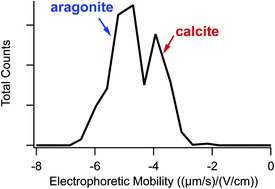Assessing the feasibility of electrophoretic separation of CaCO3 polymorphs for archaeological applications†
Abstract
We demonstrate a proof-of-principle method to separate particles of two CaCO3 polymorphs, calcite and aragonite, based on surface charge density differences that affect electrophoretic mobility values. Calcite and aragonite standards show significant differences in their electrophoretic mobility distributions in polyphosphate-containing suspensions. Phosphate additives, which are commonly used to reduce particle aggregation, have a serendipitous added benefit of stabilizing CaCO3 against dissolution. However, the mobility differences among archaeologically relevant samples, such as lime plasters and chalk, are not consistently different enough to make this a reliable separation strategy. Nevertheless, this study is important because it takes a new and fundamentally different approach to non-destructive separation of archaeological materials.


 Please wait while we load your content...
Please wait while we load your content...